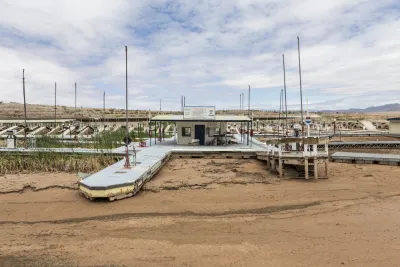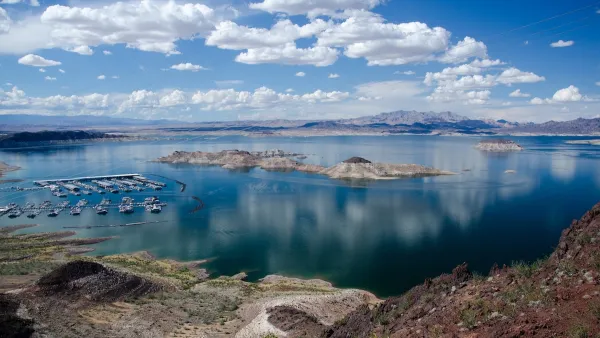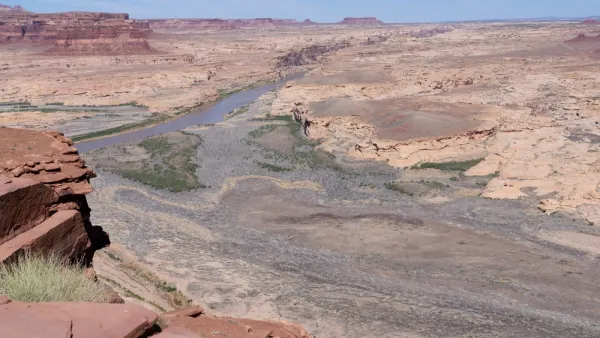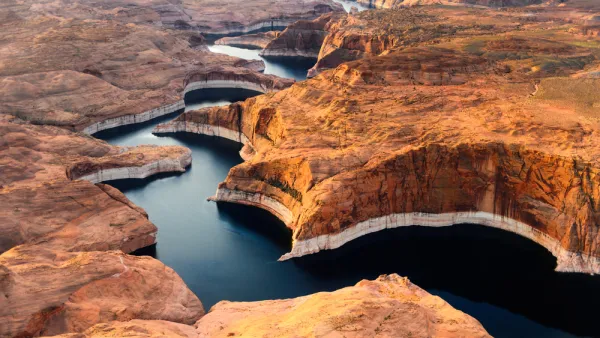Without more immediate, long-term reductions in water demand, Lake Mead and Lake Powell, the West’s most important reservoirs, face imminent collapse.

If Western states don’t make more drastic cuts to water use, Lake Powell and Lake Mead could “collapse,” writes Zak Podmore in the Salt Lake Tribune. “That’s according to a new, peer-reviewed paper published in the journal Science this week that analyzed how current agreements between basin users would fare if the 23-year trend of below-average runoff in the basin continues.”
According to the report, it “is clear that the current drought planning measures won’t cut it alone since the federal government had to enact emergency actions last April to send more water than usual into Lake Powell.”
The paper offers some recommendations based on an analysis of several scenarios. “One of many possible solutions the team identified looked at what would happen to the reservoirs if the Upper Basin states of Utah, Colorado, Wyoming and New Mexico agreed to give up water development ambitions, while the Lower Basin states of California, Arizona and Nevada, along with northwest Mexico, agreed to reductions.” If the Upper Basin limits its water use to 4 million acre-feet per year and the Lower Basin agreed to 2 million acre-feet in cuts per year, the water system could be stabilized.
Kevin Wheeler, lead author of the study, noted that if low-runoff years continue, the situation will become more dire, fast. “Last month, Bureau of Reclamation Commissioner Camille Touton announced that the seven basin states had 60 days to present plans to protect reservoir levels by making between 2 and 4 million acre-feet in water cuts by next year. Touton added that the federal government is prepared to make the reductions if the states cannot agree to a plan.”
The situation has led to tension between regions. While Lower Basin states use twice as much water as their northern neighbors, numerous projects proposed in Upper Basin states would increase their water demand. According to Wheeler, “water managers should be planning for a possible continuation of the Millennium Drought, which has reduced Colorado River flows by an average of 20% compared to the previous century’s average.”
Earlier this year, experts warned that the water level in Lake Powell had dropped to within 33 feet of the critical minimum needed to continue producing electricity.

National Parks Layoffs Will Cause Communities to Lose Billions
Thousands of essential park workers were laid off this week, just before the busy spring break season.

Retro-silient?: America’s First “Eco-burb,” The Woodlands Turns 50
A master-planned community north of Houston offers lessons on green infrastructure and resilient design, but falls short of its founder’s lofty affordability and walkability goals.

Delivering for America Plan Will Downgrade Mail Service in at Least 49.5 Percent of Zip Codes
Republican and Democrat lawmakers criticize the plan for its disproportionate negative impact on rural communities.

Test News Post 1
This is a summary

Test News Headline 46
Test for the image on the front page.

Balancing Bombs and Butterflies: How the National Guard Protects a Rare Species
The National Guard at Fort Indiantown Gap uses GIS technology and land management strategies to balance military training with conservation efforts, ensuring the survival of the rare eastern regal fritillary butterfly.
Urban Design for Planners 1: Software Tools
This six-course series explores essential urban design concepts using open source software and equips planners with the tools they need to participate fully in the urban design process.
Planning for Universal Design
Learn the tools for implementing Universal Design in planning regulations.
EMC Planning Group, Inc.
Planetizen
Planetizen
Mpact (formerly Rail~Volution)
Great Falls Development Authority, Inc.
HUDs Office of Policy Development and Research
NYU Wagner Graduate School of Public Service





























